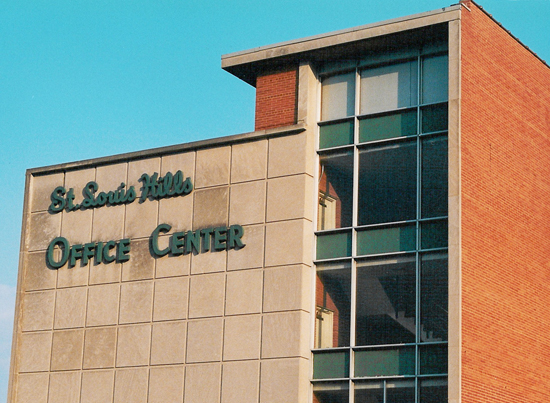 6500 Chippewa
6500 Chippewa
South St. Louis, MO
In July 2010, I was hopeful and optimistic about the construction that had started on the St. Louis Hills Office Center. Read the report here. Shy of a year later, it’s not a rebirth but a high-profile remuddle.
The new bits on the back of the building are blandly modern, all EFIS and glass grid, nothing to be excited about in either direction. But when the iconic green letters and green metal panels (seen above) disappeared from the building, it was time to find out if they were coming back (maybe they took them down for a cleaning?) and what is intended to occupy the building when it’s done?
I contacted the owner of the building, Dan Stevens, who had given us a tour of the building in 2007. He made it clear that he is no longer involved in the development of the building, and because they have destroyed all the vintage architecture of the building, does not approve of what has been done to it.
The St. Louis Hills Office Center has been owned by the Stevens family since 1974, and was put under Dan’s primary care. But in the last couple of years, more of the family has become legally and actively involved in the redevelopment, which creates group decisions with majority group votes. Dan does have experience with renovating old buildings (see the Ozark Theater in Webster Groves), but with this building, he says all of his input was outvoted. He divorced himself from the project and is deeply distressed that it has become “a huge, architecturally meaningless white elephant.”
Dan does not know what the intended use is for the completed building that’s gone way over budget. 16th Ward alderwoman Donna Barringer said the plan is to rent each floor to a company when the building is completed.
With the back wing of the building long gone, there is now a generous surface parking lot to take care of future tenants. Keep this in mind as we walk down Chippewa to see the rest of the buildings they also own on this block.
For several years now, this handsome deco brick building has been the only occupied property on the block. Even as they’ve been renovating the buildings around it, the comic store was still holding down the fort in the best looking building of the bunch.
And now it is gone, sacrificed for a surface parking lot. This is a complete tragedy and a complete waste when you view all the parking that will be available behind the office building. I realize it’s impossible to have on-street parking in front of this retail strip, which is why all these buildings have long had parking in the back, which seemed to work out for several decades. Will they be granted a curb-cut off Chippewa for this new lot? Or will patrons still have to access the alley to use it? Either answer still makes the loss of this building a deep shame.
The interior of the Office Center has been completely gutted for the new development, and the fabulous front stairwell has been exposed to the elements for several weeks now, which is disturbing. Does that mean it’s going too? Dan Stevens is taking this all so hard that I couldn’t bear to ask him.
He did say that he rescued the medical medallion that used to hang above the side door when he learned it was slated to be scrapped for its aluminum value. Learning that, chances are real good that the vintage green lettering is now landfill (and thank you to a friend for checking the dumpsters the day he discovered them missing from the building). And I’ve got a sinking feeling in my gut about the stairwell.
It is desirable to re-use a building, rather than demolish it, always. But having spent several years watching this building whittle away to a shadow of its former glory, I have to ask: Would it have been emotionally easier and developmentally cheaper to just demolish it? At least that would have been like yanking the bandage off real fast to get it over with. Instead, it has become an excruciatingly slow peel-off that takes the scab with it.
I feel bad for the building because from day one, it’s had nothing but trouble over being what it wanted to be. From neighbors in the 1950s forcing it to be redesigned, to owners in the 2010s erasing the last of its grace, the St. Louis Hills Office Center was a mid-century modern swan long gliding across the wrong lake.
See the building before demolition and remuddle

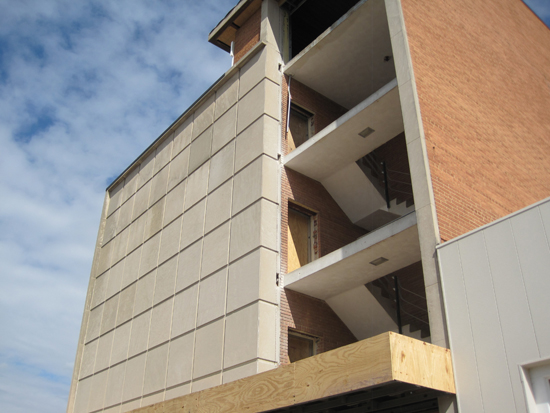
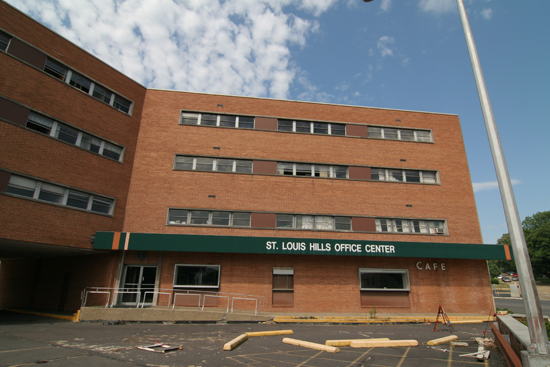
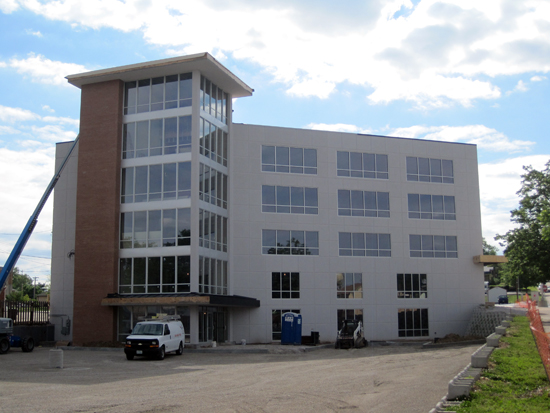
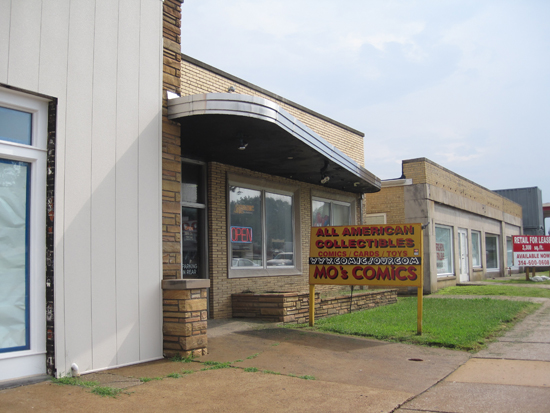
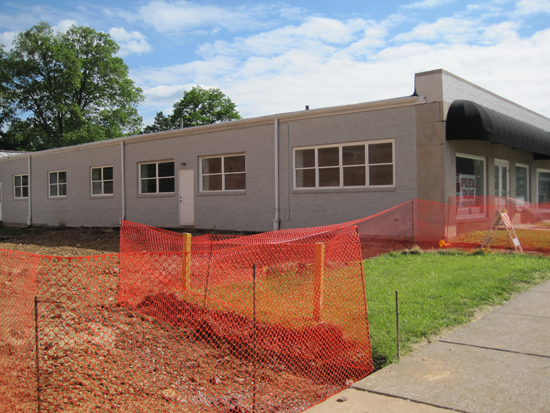
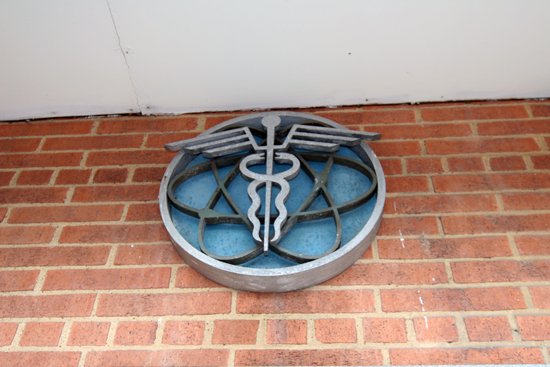
When Dan Stevens was still heading the redevelopment project, he envisioned it as apartments or condos, with restaurant retail on the ground floor. That made so much sense, and I was looking forward to the opportunity to live there. Well, not to be.
Thank you for posting the “before” photos. My memories of this building are mixed because my dentist was located there in the early 1970’s. I equate it with pain. Nearly 40 years later, it is equally as painful watching this bastardization of the landscape. This project WILL flop: Way too much office space, as it is.
This story isn’t so strange after all.
Demolition following deferred maintenance. Frustrated tenants moving out. Neighborhood treated to years of an eyesore.
How many times has this played out? It seems like the only way to avoid it is to have stricter occupancy codes – or higher rents.
Maybe the two would go together?
p.s.- The comic shop had about 6 parking spaces behind his shop.
Admin:
The comic book owner left in December of 2010. He had discussed with them for many months that the roof was leaking, and well water and comics don’t really go together. They said his rent would be increased in 2011 and he said that was enough. He put up with a lot, and frankly I would not have stayed as long as he did. The shop stayed in STL Hills, he is now on Hampton just South of Loughborough. (The old JunkJunkie shop)
A. Torch,
I posted early on in this thread that “I haven’t followed the issue at the neighborhood level at all, but my guess is that those neighbors have long complained to the aldermen of the 16th ward (Baringer now, Shrewsbury previosly),”, so, no, I don’t claim to have been personally involved in this issue.
But I do know leaders of the neighborhood organization personally and have friends living on the block adjacent the StL Office Center, so I can ask them about their experiences, wishes, efforts, etc.
If I find out anything, I can post it here.
ALderman Baringer is probably the best source for neighborhood sentiment, and according to the post, the residents supported the demo of the comic shop and creation of surface lots.
Maybe they were tired of shoppers at the businesses parking in front of their houses?
Hey, A. Torch, when did they tell the comic store to vacate?
It makes no sense to tear down the one and only building that actually had a paying tenant. Meaning, it was the only building in the row that still functioned and conveyed it could be a desirable place to have a business. Now it’s a ghost town devoid of any of its original charm. The whole thing is so illogical.
I don’t think there is ANY dispute that destroying the dilapidated parking garage was/is the only bright point in this situation so far. I hope for the sake of the neighborhood that some valuable businesses end-up in the building.
Actually Rick, I did, as much as I (as a concerned bystander) could; my friend owned the comic shop. I didn’t see you anywhere.
Adam and everyone else in this thread –
Thanks for a good give and take. With first name only or pseudonym poster names, I feel like the only person in this thread (other than Rob Powers) I really have a connection/acquaitenance with is Toby. Maybe someday we all meet in person. That would be nice.
So if you don’t know me, or if you do, you might be dismayed with my apparent approval or defense of non-historic rehab or demolition. That is not the case.
My first loyalty is to neighborhood and city residents. I side with them nearly 100% of the time.
In a city with a well-established ad hoc approach to lots of planning efforts, I side with neighborhood residents and organizations.
They live with the problems and they are almost always the ones working to make positive change. If you see an elected official carrying the banner for something, you can be fairly certain they have neighborhood support behind them.
When they stay away from issues, chances are, they are unpopular with their constituents. None of this is rocket science.
To those in the preservation arena, they would be well-served taking their goals and visions out to the neighborhoods to get active support at the neighborhood level.
In some neighborhoods, like the CWE, Soulard, and Lafayette Square, that work was done decades ago. In other places, like Forest Park Southeast and Tower Grove East, it’s more recent. In others, like O’Fallon and Lindell Park, it’s in the earlier stages with National Register historic districts either in the conversation or formal nomination stages.
However, in all of these cases, work from average residents to preserve and improve the communities is vital. The larger neighborhood is more important than one building. Crime in my alley is more important to me than the possible demolition of a building at the end of the block.
So I always side with neighbors and neighborhood groups. They are there (hopefully) for the long run. It’s great when the quality of life in our neighborhood is so strong that we have time to turn our attention to design details on rehabs!
admin,
are there actually documented cases (i.e. police reports) of vandals and vagrants occupying the building? more than a couple? if so, then like i conceded before it makes the demolition more justified in my mind.
also, i admit that until your just reminded me, i forgot that the razed portion was a parking garage. however, if the intent of the owners is to maintain the vacated land as a parking lot, as opposed to building on it or selling to another developer, i don’t see this as much of an improvement.
Rick,
i didn’t claim it was one or the other. i simply questioned the rationale for demolition and lamented the addition of yet two more surface parking lots. like i said, if there was a serious issue with vagrants/ vandals then i’m not so disturbed by the demolition of a parking garage. however, it seems that such an excuse could easily be embellished by an owner looking to get rid of a liability.
the situation across the street however, had nothing to do with vagrants, vandals, or vermin. why didn’t the neighbors oppose that demolition? why didn’t they raise a stink? i’m not blaming the neighbors per se, and i agree that good policy would make such individual battles less prevalent, but if not the neighbors then who is going to advocate for such policies? the answer is always “the other neighbors” of course. as long as saint louisans are satisfied with a city of island-neighborhoods in a sea of asphalt and concrete, that’s what we’ll get.
Adam –
Just a few points in response to your last post.
First, I don’t think it’s fair to blame the neighbors for not setting a design standard on the development – they were focused on a more basic need: their quality of life.
Second, in terms of false choices, you’ve made one. The choice was not between an abandoned building and one or two surface parking lots. The facts are that there is now two surface lots and one large building under rehab (not historically accurate, but still under rehab).
Lastly, I hope I’ve been able to bring out some of the other pressing issues in a case like this, namely neighborhood concerns and priorities. St. Louis is a city of neighborhoods. If you want to make an impact at the neighborhood level, the best way to do it is to work through local neighborhood groups and elevate your priorities among the neighbors.
That takes a lot of time and effort and not the sort of thing that usually works on a building by building or ad hoc basis. If things are approached ad hoc, or one building at a time, it’s almost always too late to do anything.
Case in point…will we be having similar discussions when the Art Deco Avalon Theater is demolished? It period of abandonment rivals if not exceeds that of the STL Hills Office Center, and I can pretty much guarantee you that the preservation of the Avalon does not top the list of SOHA neighborhood concerns.
Adam, the original building WAS causing quality of life issues for the neighbors directly behind it. The parking garage wing was harboring vandals and homeless which equals trash which equals vermin. The first compromise between owner and neighborhood was demolishing that parking garage, which happened in 2007.
Rick,
what kinds of options were the neighbors given? my guess is none. the neighbors didn’t say “this is what we would like to see.” the developer said “this is what we’re giving you. take it or leave it.” maybe the neighbors need to take a slightly less basic approach next time.
to answer your question above, no i do not agree. point me to some evidence that the abandoned building was causing a vermin problem for the neighborhood and maybe you’ve got something. otherwise your quality of life argument is weightless and you’re simply opining that a parking lot is more attractive than an abandoned building, which is subjective (actually two parking lots, across the street from one another, one of which replaced a perfectly habitable sidewalk-fronting building). saint louis is consistently ranked one of the least healthy cities in the country. i wonder if that has anything to do with our glut of parking lots? quality of life, indeed. i’m less concerned about historic preservation in this case and more concerned that saint louis just became a less desirable place to live (as evidenced by the populations of cities in which people actually walk or take public transit, vs that of saint louis).
The design standards have been determined by the group paying the remodel bills. They have no aesthetic understanding or sense about the building, and what they are doing is perfectly acceptable by modern renovation standards. There is a good chance that the residents around it have the same perspective. Owners and residents are concerned with productive and undisruptive, which is fair.
That’s part of the struggle with MCM architecture: everyone is still in a learning curve, so it’s too often not even on the plate as a consideration.
If that’s true, then why the outcome here? I did not hear any cry for design standards in the redevelopment of the building. A. Torch, did you?
I disagree; speaking as someone who lived in the area and still converses with neighbors in that 6 block radius, you are incorrect to assume preservation and design is not very high on their list. The pitting of re-use vs. some preservation of design/feel/style is often overblown for those developers who are short-sighted and/or did not plan their budget well (see Webster Theatre rehab and zoning surprise)and/or do not care about historic preservation. They ARE concerned about the ‘STL Hills Look’ and preservation of it.
Rob – The issue I’m addressing is neighborhood involvement. The neighborhood seems to have taken a pretty basic approach – we have a vacant/abandoned building blighting our area – deal with it.
Design concerns were not their top priority. The dilapidated state of the building was.
St. Louis Hills has no design standards beyond the basic zoning code. As an aside, it’s possible this project went through a blighting and redevelopment process, so there may have been conditions put on the design there, but probably not historic preservation conditions if no federal money involved.
Neighborhood involvement takes a big commitment of time on the part of a lot of people. Projects, priorities and and plans take years to develop and carry out.
Neighbors work on a lot of stuff, and design issues do not always go to the top of the list. Poll STL Hills residents, and probably very few see historic preservation around STL Hills as a top priority.
They’re probably more likely to identify maintenance of property values, condition of parks, crime prevention, and other broad quality of life priorities.
If people want to push historic preservation and design standards up the list of priorities, they need to get personally involved to create a foundation for those efforts alongside the long list of other priorities and neighborhood goals.
Rick – you’re positing a false dichotomy. There are more options than “the way it is being done” and “nothing at all” – leaving the existing facade alone, for example, which by the by would cost less than taking it apart and slathering it with EFIS.
Adam –
Yes, it’s definitely better than the abandoned building they’ve shared an alley/streetscape with for the better part of 10 years – a veritable breeding ground for piles of trash and vermin.
Agreed?
Consider this…
Neighbors work to improve their homes and neighborhood, for years, house by house, block by block, while a big, abandoned, white elephant of a building sits outside their door.
Who/what counts more? The architectural significance of an abandoned building or the quality of life of its living and breathing neighbors?
It’s easy now to decry the reuse of the abandoned building, all the while disregarding the abandonment, blight, and uncertainty the property presented for a decade to its neighborhood and neighbors.
– Rick
^ well now the neighbors can look out their windows at big wastelands of asphalt (soon to covered in trash and oil and devoid of human life) and a cheap, suburban-looking renovation. apparently that’s way better.
Alex –
I don’t know where you live, but it sort of sounds like you’re in the 23rd ward and Lindenwood neighborhood. Maybe not.
One of the first rules of neighborhood involvement is home rule. Since the St. Louis Hills Office Center is in St. Louis Hills (and the 16th ward), what St. Louis Hills, the neighborhood organization, wants, takes as an official position, etc, is given the highest level of consideration.
On the other hand, it’s highly unlikely that Lindenwood would weigh in or take a contrary position on the matter from that of STL Hills. And vice-versa in other matters. Lindenwood wouldn’t want STL Hills interloping on matters in Lindenwood, and so it goes. It’s a system not unlike the tradition of aldermanic courtesy. That’s how St. Louis works.
The system is far from perfect, but it is tried and tested, now practiced as a years’ long standing tradition.
I think it’s Bancroft that is directly adjacent/south/across the alley from the STL Hills Office Center. Those neighbors have been unhappy with the dilapidated state of the building for years.
I haven’t followed the issue at the neighborhood level at all, but my guess is that those neighbors have long complained to the aldermen of the 16th ward (Baringer now, Shrewsbury previosly), those concerns were raised up the ladder to the STL Hills neighborhood association, and it’s possible that the neighborhood association worked as an advocate for the long term concerns of the immediate neighbors.
This all might sound like a highly parochial, byzantine way of doing things, but it’s also good knowing that people are backed by their community organizations and that there is solidarity among neighbors over the long term.
I live 2 blocks from this building, can see it from my backyard and think what’s happening now is a disgrace.
You could say I’ve had a front row seat to what has happened to this once classy building.
I was surprised that the comic book store building was torn down for a parking lot given the fact that there is a large parking lot adjacent to the office building.
I contacted Alderman Barringer and asked her why the building had been torn down and she said the building owner needed parking to lease the smaller spaces…and that residents on the street behind the building and the St. Louis Hills Neighborhood Assoc. President approved the demolition and were happy with it.
Why was only one street contacted to weigh in on possible demolition?
I, too, was hopeful this restoration was going to benefit the building. I had a funny feeling in my stomach when the “St. Louis Hills Office Center” came off the building that things may not turn out good, when the comic book store building was demolished my heart sunk, and now that the windows have been torn out of the front facade and exposed for weeks my enthusiasm for the project has almost turned into loathing.
It’s important to note that the building stood a vacant eyesore for a decade or more. Neighbors looked out their front doors at an abandoned building. It was a blight. A big, ugly, blight.
Would demolition have been better? Would an accurate historic rehab been better? Would a vacant building hoping for a better future been better?
Out of all of the above, I bet that nearly all people living within a 2-3 mile radius believe that what is happening now is far better than waiting indefinitely for something more.
Had demolition come ten years ago, they probably would have been okay with it.
The lesson of the story is that most people have really bad taste.
so all the land that was occupied by the demolished portion is becoming surface parking? ugh, and the mo’s comics demo just makes me sick… i loved that awning. property owners in saint louis should be given forced interventional architectural tours of functional cities so they can realize how utterly shortsighted and counterproductive they are.
Thank you for the report. What an odd story.